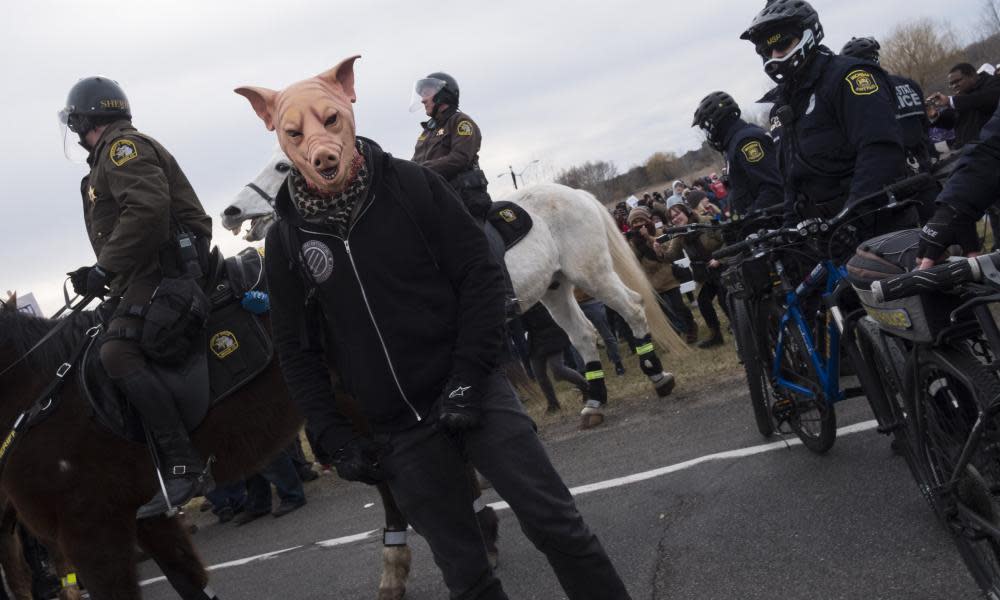The alt-right is in decline. Has antifascist activism worked?

The alt-right appears to be falling apart. The Traditionalist Workers party disintegrated this week after a lurid interpersonal drama among its leadership. Richard Spencer says his alt-right rallies aren’t “fun” any more, and is rethinking his college tour in the aftermath of his fizzer of an event in East Lansing, Michigan, two weeks ago.
It’s a good time to offer an observation: on the terms it set itself, antifascist organizing in the United States has worked.
Consider the failure of Spencer’s long-planned address at Michigan State University. Though it was spring break, students and organized antifascist groups showed up to protest, and Spencer gave his pitch for a white ethnostate to an almost empty auditorium. He issued 150 tickets, but only managed to get 20 people along. Spencer himself blamed the protesters for the event’s failure, just as he is blaming them for his movement’s declining ability to muster any numbers in public.
And that non-event was not an outlier. The same weekend, a planned alt-right conference in Detroit fell apart after venues pulled out under public pressure and one of the organizers, lawyer Kyle Bristow, announced he was leaving the movement. Various “March 4 Trump” events around the country, featuring alt-right contingents, were also small, and met with significant counterprotests.
Other events in the latter half of last year were also poorly executed and sparsely attended. On a recent podcast, Spencer said the movement was “in a dark place”. And it has been put there by those determined to oppose it.
Throughout 2017 and into 2018, antifascists have consistently showed up to, and disrupted, public far-right gatherings. After I saw its numbers peak at Charlottesville, Virginia, last summer, the openly white supremacist and fascist segment of the far right has been consistently opposed and usually outnumbered by counterprotesters at events around the country.
It seems that the white supremacist alt-right will not survive the Trump era as a coherent movement
From my perch in Portland, Oregon, I have seen antifascists show up month in, month out to publicly oppose far-right organizing. In some instances, such as in Boston last 19 August, rightwing rallies have faced opposition numbering in the tens of thousands.
The far right’s online organizing has also been targeted. Antifascist websites like Unicorn Riot have obtained logs from servers used to organize events like Charlottesville. As well as using them in their own reporting, they have made them available to mainstream news organizations. (ProPublica’s recent reporting on secretive neo-nazi group AtomWaffen was based on similar leaked chat logs.)
These materials, as well as media reporting, have been used to identify and expose far-right activists to their families, teachers and employers, in the communities they live in.
For many on the alt-right, this has led to serious legal consequences. Rightwing Charlottesville participants are awaiting trial on charges ranging from murder to felony perjury. Cases like that of Oregon’s Andrew Oswalt, who was in student government until exposed as a far-right activist, and was charged with a felony hate crime, show that this kind of work is going on away from highly publicized events.
And major tech platforms and their advertisers have been pressured to exclude far-right voices, and they have been responding. From late last year, Twitter began excluding alt-right accounts en masse, and recently YouTube has appointed more moderators to police beefed-up policies on hate speech. Far-right users have increasingly retreated to smaller, more accommodating platforms.
Antifascist groups have been the target of criticism from across the political spectrum during the first year of the Trump presidency. The right has made them the basis both of moral panics about violence, and conspiracy theories of subversion. And other leftists have questioned the wisdom of antifascist tactics and strategy.
The morality of political violence is a weighty, and always important topic, which we need to constantly scrutinize and revisit. That said, most of the antifascist tactics described above are nonviolent. And a lot of antifascist violence has been defensive, notably in Charlottesville.
As to tactics, the proof is in the pudding. All of the measures described have led not only to failed events and dwindling cadres, but to infighting and blame games in an increasingly fractious far-right movement. Seriously divided, the alt-right looks like it is crumbling.
The broader hard right is still active, and energized. The growth of groups like the Proud Boys shows that you don’t need to tote swastikas to engage in political violence, and Turning Point USA shows how attacking the left can be given a veneer of respectability.
There’s also the fact that during the Trump era, a lot of far-right political beliefs have been partially mainstreamed – the resurgence of public antisemitism is just one indicator of that.
But it seems that the white supremacist alt-right will not survive the Trump era as a coherent movement. If so, antifascist activists can take a large measure of credit.

 Yahoo News
Yahoo News 
